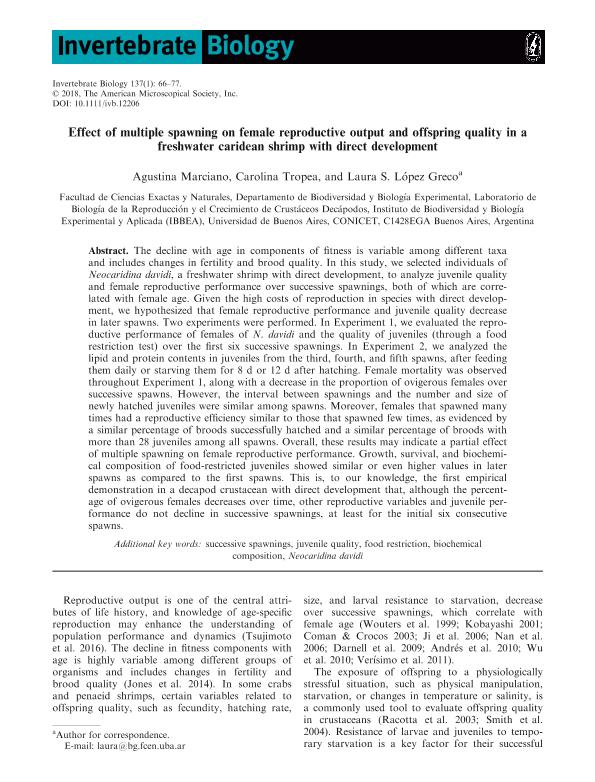Mostrar el registro sencillo del ítem
dc.contributor.author
Marciano, Agustina

dc.contributor.author
Tropea, Carolina

dc.contributor.author
Lopez, Laura Susana

dc.date.available
2020-01-30T19:55:02Z
dc.date.issued
2018-03
dc.identifier.citation
Marciano, Agustina; Tropea, Carolina; Lopez, Laura Susana; Effect of multiple spawning on female reproductive output and offspring quality in a freshwater caridean shrimp with direct development; Wiley Blackwell Publishing, Inc; Invertebrate Biology; 137; 1; 3-2018; 66-77
dc.identifier.issn
1077-8306
dc.identifier.uri
http://hdl.handle.net/11336/96286
dc.description.abstract
The decline with age in components of fitness is variable among different taxa and includes changes in fertility and brood quality. In this study, we selected individuals of Neocaridina davidi, a freshwater shrimp with direct development, to analyze juvenile quality and female reproductive performance over successive spawnings, both of which are correlated with female age. Given the high costs of reproduction in species with direct development, we hypothesized that female reproductive performance and juvenile quality decrease in later spawns. Two experiments were performed. In Experiment 1, we evaluated the reproductive performance of females of N. davidi and the quality of juveniles (through a food restriction test) over the first six successive spawnings. In Experiment 2, we analyzed the lipid and protein contents in juveniles from the third, fourth, and fifth spawns, after feeding them daily or starving them for 8 d or 12 d after hatching. Female mortality was observed throughout Experiment 1, along with a decrease in the proportion of ovigerous females over successive spawns. However, the interval between spawnings and the number and size of newly hatched juveniles were similar among spawns. Moreover, females that spawned many times had a reproductive efficiency similar to those that spawned few times, as evidenced by a similar percentage of broods successfully hatched and a similar percentage of broods with more than 28 juveniles among all spawns. Overall, these results may indicate a partial effect of multiple spawning on female reproductive performance. Growth, survival, and biochemical composition of food-restricted juveniles showed similar or even higher values in later spawns as compared to the first spawns. This is, to our knowledge, the first empirical demonstration in a decapod crustacean with direct development that, although the percentage of ovigerous females decreases over time, other reproductive variables and juvenile performance do not decline in successive spawnings, at least for the initial six consecutive spawns.
dc.format
application/pdf
dc.language.iso
eng
dc.publisher
Wiley Blackwell Publishing, Inc

dc.rights
info:eu-repo/semantics/openAccess
dc.rights.uri
https://creativecommons.org/licenses/by-nc-sa/2.5/ar/
dc.subject
BIOCHEMICAL COMPOSITION
dc.subject
FOOD RESTRICTION
dc.subject
JUVENILE QUALITY
dc.subject
NEOCARIDINA DAVIDI
dc.subject
SUCCESSIVE SPAWNINGS
dc.subject.classification
Otros Tópicos Biológicos

dc.subject.classification
Ciencias Biológicas

dc.subject.classification
CIENCIAS NATURALES Y EXACTAS

dc.title
Effect of multiple spawning on female reproductive output and offspring quality in a freshwater caridean shrimp with direct development
dc.type
info:eu-repo/semantics/article
dc.type
info:ar-repo/semantics/artículo
dc.type
info:eu-repo/semantics/publishedVersion
dc.date.updated
2019-10-02T19:13:11Z
dc.journal.volume
137
dc.journal.number
1
dc.journal.pagination
66-77
dc.journal.pais
Reino Unido

dc.journal.ciudad
Londres
dc.description.fil
Fil: Marciano, Agustina. Consejo Nacional de Investigaciones Científicas y Técnicas. Oficina de Coordinación Administrativa Ciudad Universitaria. Instituto de Biodiversidad y Biología Experimental y Aplicada. Universidad de Buenos Aires. Facultad de Ciencias Exactas y Naturales. Instituto de Biodiversidad y Biología Experimental y Aplicada; Argentina. Universidad de Buenos Aires. Facultad de Ciencias Exactas y Naturales. Departamento de Biodiversidad y Biología Experimental; Argentina
dc.description.fil
Fil: Tropea, Carolina. Consejo Nacional de Investigaciones Científicas y Técnicas. Oficina de Coordinación Administrativa Ciudad Universitaria. Instituto de Biodiversidad y Biología Experimental y Aplicada. Universidad de Buenos Aires. Facultad de Ciencias Exactas y Naturales. Instituto de Biodiversidad y Biología Experimental y Aplicada; Argentina. Universidad de Buenos Aires. Facultad de Ciencias Exactas y Naturales. Departamento de Biodiversidad y Biología Experimental; Argentina
dc.description.fil
Fil: Lopez, Laura Susana. Consejo Nacional de Investigaciones Científicas y Técnicas. Oficina de Coordinación Administrativa Ciudad Universitaria. Instituto de Biodiversidad y Biología Experimental y Aplicada. Universidad de Buenos Aires. Facultad de Ciencias Exactas y Naturales. Instituto de Biodiversidad y Biología Experimental y Aplicada; Argentina. Universidad de Buenos Aires. Facultad de Ciencias Exactas y Naturales. Departamento de Biodiversidad y Biología Experimental; Argentina
dc.journal.title
Invertebrate Biology

dc.relation.alternativeid
info:eu-repo/semantics/altIdentifier/doi/https://doi.org/10.1111/ivb.12206
dc.relation.alternativeid
info:eu-repo/semantics/altIdentifier/url/https://onlinelibrary.wiley.com/doi/10.1111/ivb.12206
Archivos asociados
